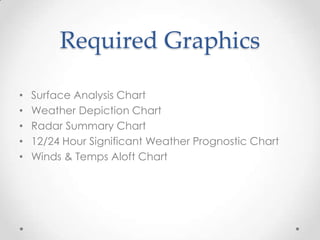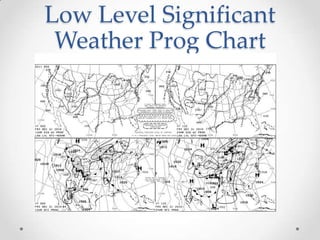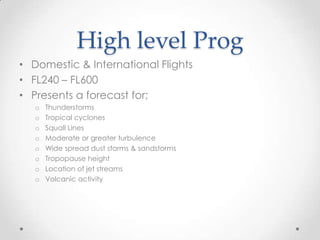Weather graphics
- 1. Graphic Weather Products & How to Read Them
- 2. Graphic Wx Products âĒ Quickly access large-scale weather patterns âĒ Identify trends âĒ Predict wx that might occur over time âĒ Identify areas of IFR wx at a glance âĒ See where IFR conditions are forecast within the next 12-24 hours
- 3. Required Graphics âĒ Surface Analysis Chart âĒ Weather Depiction Chart âĒ Radar Summary Chart âĒ 12/24 Hour Significant Weather Prognostic Chart âĒ Winds & Temps Aloft Chart
- 5. Surface Analysis âĒ Depicts an analysis of the current surface weather âĒ Computer prepared every 3 hours âĒ Shows; o Areas of pressure o Fronts o Temperatures o Dew points o Wind Directions & Speeds o Local Weather o Visual Obstructions
- 6. Station Model âĒ Created by computer âĒ Mainly on surface- weather maps âĒ Winds are true direction âĒ Temp/Dew point is in Fahrenheit
- 7. So What Do I Need To Know? âĒ A good source for general weather information over a wide area. âĒ Depicts the actual position of fronts, pressure patterns, temperatures, dew point, wind, weather, and obstructions to vision at the valid time of the chart. âĒ When the Isobars are close the pressure gradient is greater meaning wind velocities will be stronger. âĒ Dashed lines indicate a weak pressure gradient.
- 9. Wx Depiction âĒ Derived from METARâs âĒ Prepared every 3 hours beginning at 0100Z by a computer âĒ Used for flight planning âĒ Displays o Major fronts o Areas of pressure o Graphic display of IFR, MVFR, VFR o Shows a modified station model
- 10. Modified Station Model âĒ Sky Conditions âĒ Cloud height or ceiling âĒ Weather âĒ Obstructions to visibility âĒ Same as Surface Analysis
- 11. So What Do I need To Know? âĒ Some may be automated âĒ Bases shown are the lowest layer
- 12. Radar Summary
- 13. Radar Summary (SD) âĒ Computer generated âĒ Published hourly, 35 minutes past the hour âĒ Displays areas of precipitation as well as the characteristics of the precipitation.
- 14. SD âĒ NA â No information Available âĒ NE â No echoes âĒ Height of tops in hundreds of feet MSL âĒ Movement of cells depicted by arrow
- 15. So What Do I Need To Know? âĒ The only charts that show lines and cells of thunderstorms âĒ You can determine the tops and bases of echoes, the intensity of the precipitation, and the echo movement. âĒ Most effective when used in combination with other charts, reports, and forecasts.
- 20. Composite Moisture Stability Chart âĒ Four Panels showing stability, precipitable water, freezing level, & average relative humidity conditions. âĒ Computer generated âĒ Obtained from upper air observations âĒ Updated twice daily âĒ Stability = Potential for thunderstorms âĒ You will not find this chart anywhere in the current system
- 21. Constant Pressure Analysis Chart
- 22. Composite Moisture Stability Chart
- 23. Low Level Significant Weather Prog Chart
- 24. Prog Charts âĒ SFC to FL240 (400 Millibar) âĒ 12/24 hour forecast, and 36/48 forecast âĒ Issued four times daily âĒ Valid time is printed on it
- 25. Prog Charts Upper Panels Lower Panels âĒ Shows forecasted âĒ Forecast surface wx significant weather o Pressure systems o Non-convective turbulence o Fronts (dashed lines) o Precipitation o Freezing levels (zigzag lines) o IFR (solid lines) o MVFR (scalloped lines)
- 26. High-Level Significant Weather Prog Chart Issued 4 times a day
- 27. High level Prog âĒ Domestic & International Flights âĒ FL240 â FL600 âĒ Presents a forecast for; o Thunderstorms o Tropical cyclones o Squall Lines o Moderate or greater turbulence o Wide spread dust storms & sandstorms o Tropopause height o Location of jet streams o Volcanic activity
- 28. Convective Outlook Chart Convective Graphics
- 29. Conv. Outlook âĒ Issued five times daily âĒ Convective Activity âĒ Hail âĒ Tornadoes âĒ Winds
- 30. Hail
- 31. Tornado
- 32. Winds
- 33. Forecast Winds & Temperatures Aloft Chart
- 34. FD âĒ 12 hour forecasts valid at 0000Z & 1200Z daily âĒ Read same as station model winds âĒ 99 for calm winds with no arrow âĒ Temps are shown in Celsius


































